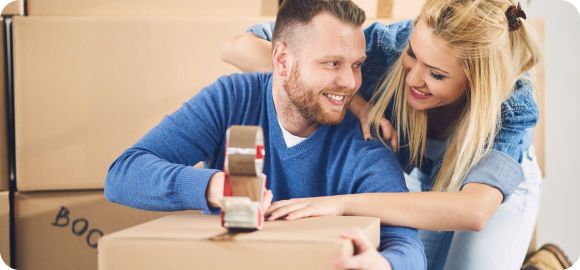These handy tips wil make your move a piece of cake.
1. Get rid of clutter
For the easiest packing process possible, make sure there is no clutter obstructing anyone’s path. There’s no reason not to enjoy the process! With a move around the corner, there isn’t a better occasion to consider the stuff you will need in your new home and what you won’t.
2. Categorize
It’s a tale as old as time: jumbling books together with cutlery creates wasted space inside a box and maximizes the opportunity for damage. Utilize the space in your box to its fullest (literally) by sorting each box by category: books, clothing, power cords, photo albums, etc.
3. Make a list
Get a glimpse of everything you own and prepare to individually label all boxes. Start with what you are going to pack first and the kind of materials you currently have at your disposal.
4. Be smart about what you pack
A few items shouldn’t be packed before a move. They either should not to be packed by you or are not permitted to be transported per legal guidelines. Scores of clients have made packing difficult for themselves by packing the wrong things. Don’t be like them!
Certain goods are notoriously hard to pack, but are always included in Move Happy’s standalone, basic moving service. From years of experience, we know that it is sometimes easier to leave certain items to professional care. Our team will pack items such as televisions, large lamps, electronic devices, small mirrored surfaces and statues, art pieces, glasses, or marble goods, and all your hung clothing. Take a look at our list of goods that our team packs for every move.
5. Get some 5-pound tissue
It’s wasted effort when you use newspapers to pack your stuff. Ink rubs off, spreads, and smudges your possessions, leaving unsightly stains. You should only use plain tissue when you wrap delicate goods. To add a bit more safety, we suggest you wrap your dishes, glass vases, and sculptures with 10-pound packing paper; it is ideal for packing delicate and priceless items and saves so much room in boxes.
6. Secure the right boxes
There’s usually a day or so between departing your old house and arriving at your new home. Make or buy a small box for things you will use in the meantime, like a couple of dishes, mugs, glasses, and small appliances. Use larger boxes for lighter goods and smaller boxes for heavier goods. Despite your best intentions, putting heavier goods in larger boxes will often break or damage the box and leave it unusable. This might seem blatantly obvious, but this tip will smooth your move.
7. Find a wardrobe box
We have wardrobe boxes to make it easy for you to hang clothing, with plenty of space at the back for sneakers and other odds and ends. They are constructed with heavy duty cardboard for extra holding strength. They also feature a handy front access panel with built-in hand holes to make carrying easy.
8. Seal the bottom of boxes with tape
Before putting something in a cardboard box, always apply tape to the bottom. Otherwise, the box’s bottom will collapse when lifted . And don’t fold each flap of the box over each other — it counteracts the structure. Always wait until the last minute to tape every box shut, because there might be something missing.
9. Get your camera out
This will save you effort and time during retrieval. Just take a few snapshots of each box once you’ve fully packed them.
Bonus tips: how to buy the right packing materials
Packing labels and tape
Don’t waste your hard-earned cash on low-quality bargain brands. They won’t secure your boxes firmly, and more often than not, they shred to pieces.
China and dish boxes
You can make use of special boxes for weightier things such as ceramics, cutlery, pots, pans, and whatever is in your kitchen drawers and cabinets.
Linen boxes
Pack bigger, lighter items in these boxes, like baking dishes, drying racks, or smaller appliances.
Book box
Book boxes are bigger and more stable than similar boxes you can buy. Book boxes can be put to use for moving and carrying heavy possessions such as a record collection, photo frames, Blu-Rays, and cutlery.
Big black marker pens
Using a black marker pen is the easiest way to label a box. Be sure to label boxes by room, and to number each box with reference to your listed inventory.
5-pound tissue and 10-pound packing paper
Make sure you use plain tissue to wrap fragile goods. For extra safety, we recommend wrapping dishes, vases, and artwork with premium packing paper. It is ideal for more delicate items and doesn’t take up much space in a box.
Card dividers
Handy cardboard dividers fit in a box so that glasses and wine bottles are kept safe. You may also use them for separating kitchen or dining room glass objects. Make sure you get the right dividers that fit in the box.








